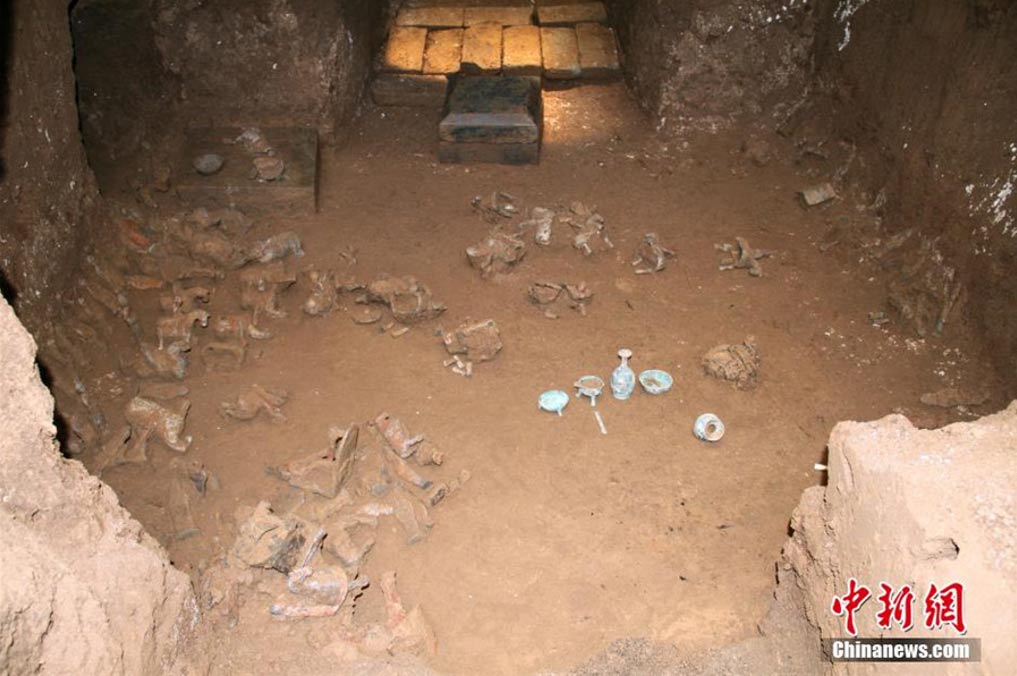Tomb of a nomadic tribal princess will help unravel China’s complicated ethnic history
Chinese archaeologists have excavated the sixth century tomb of a nomadic tribal princess of the ancient Tuyuhun Kingdom in northwest China’s Shaanxi Province. In the tomb they found two skeletons and 166 grave artifacts, including bronze ware, warrior and animal statues and inscriptions.
The political and ethnic scene was very complicated at the time, but nomadic tribes from the West settled in the eastern parts of Qinghai and established the Tuyuhun kingdom or dynasty. The princess’s tomb dates to around 557 to 581 AD. Scholars say the grave and its contents will help them learn about the history of ethnic groups of ancient China.
The archaeologists concluded that the tomb was of the Tuyuhun Huihua princess. News stories out of China do not further identify the princess but say her nomadic tribe was related to the Xianbei of the Qilian Mountains and the upper Yellow River valley. The stories also do not say who the second person in the grave may have been.
When the Xianbei kingdom disintegrated in the third century Khan Tuyuhun led his nomadic people to the pasture lands near Qinghai Lake. In 284 AD the Tuyuhun people subjugated about 100 loosely coordinated tribes of the area referred to as the Qiang people. This is considered the first year of the Tuyuhun Empire. Previously those tribes had not submitted to any outside authority.
The 60 sons of the first emperor, whose name was Murong Tuyuhun, expanded his empire by defeating the Xia and Western Qin kingdoms. The Xianbei then joined with the Tuyuhun. The Xianbei people were the most prominent citizens of the Tuyuhun Empire, and their population was about 3.3 million at the height of the realm’s power.

A statue of a loaded camel in the princess’s tomb may speak to the Tuyuhun’s development of the southern part of the Great Silk Road. (China News photo)
Tuyuhun/Xianbei forces made military forays west, reaching as far as Xinjiang and the eastern borders of Kashmir and Afghanistan. Eventually the empire encompassed most of Tibet, northern Sichuan, eastern Shaanxi and Qinghai, Gansu and Ningxia. It reached 1,500 kilometers (930 miles) from west to east and 1,000 kilometers (620 miles) from south to north.
The Tuyuhun for the first time known unified inner Asia and helped construct and manage the southern part of the Great Silk Road. They promoted trade and cultural exchanges between the west and east and dominated the northwest of China until the Tibetans destroyed their empire after about 350 years.
When the kingdom disintegrated, in 672, the Tuyuhun people split into two groups, one going east of the Qilian Mountains into central China and the rest subjugated by the Tibetan Empire.
The ethnic Xianbei people were then scattered over a large territory from northwest into central and eastern China. Most of them settled near Mount Yin near Ordos. In 946, a Shatuo Turk killed Xianbei leader Bai Chengfu. He was so rich legend says his horses had silver mangers. The Turk, Liu Zhiyuan, used the stolen wealth to establish the Later Han Dynasty, which lasted only three years—China’s shortest-reigning dynasty.
The Tuyuhun Empire is considered separately from China by historians. The Tuyuhun practiced agriculture and also had a system of writing, and, as the grave goods of the princess testify, they had metallurgy.
Featured image: The inside of the princess’s large tomb, which contained 166 funerary items (China News photo)
By: Mark Miller

















